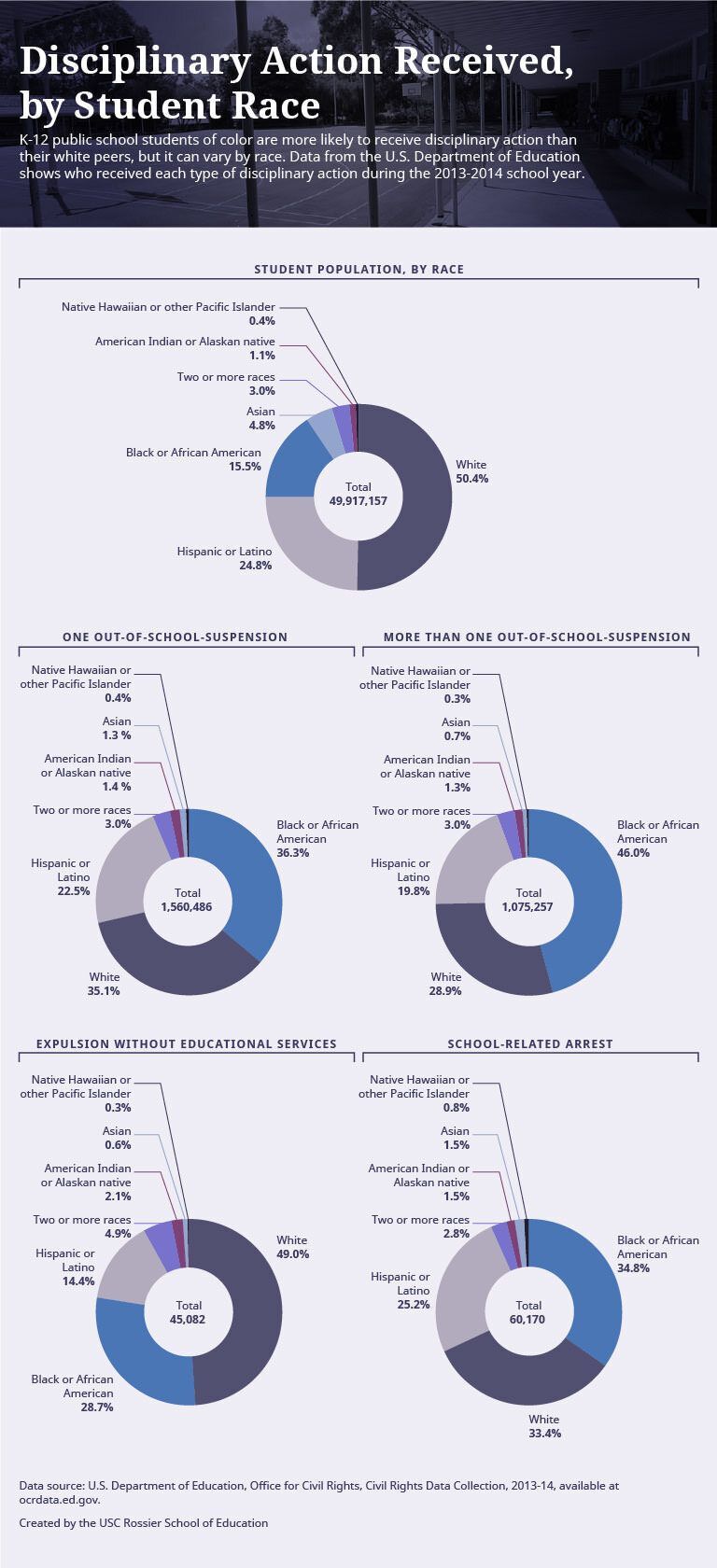by Michelle Strom
January 08, 2018
In 2016, police pepper-sprayed two students in a lunchroom fight at a high school outside St. Petersburg, Florida. The honor roll students, charged with disorderly conduct, said they were defending a female student who was attacked by a male student in the cafeteria.
They also filed a civil rights complaint External link against the Pinellas County School District with the Justice Department, saying their arrests were indicative of systemic discrimination in the county’s public schools.
Officers of the Pinellas County Schools Police Department “never use pepper spray on white students,” said one of the students, identified in the complaint only as “P.P.” “They never arrest white students for fighting.”
P.P.’s allegation is backed by research. A report from the American Psychological Association External link found a direct correlation between punitive discipline policies (detention, suspension, expulsion) and racial disparity. These schools also have lower rates of school climate and safety, as well as lower scores on academic achievement. Together, these variables funnel students to increased interaction with crime and poverty.
“Schools are funneling students [of color] out of classes and schools and into systems that will only further criminalize them,” said Taharka Anderson, restorative justice coordinator at the California Conference for Equality and Justice (CCEJ).

This phenomenon, known as the school-to-prison pipeline, disproportionately affects children of color, students with special needs, and students from low-income families and single-parent homes.
Citing Florida Department of Education statistics, the 2016 Pinellas County complaint said that while blacks made up 19 percent of the district’s students, they accounted for 59 percent of school arrests. And black students were nearly four times more likely to be arrested than white students. In about 20 county schools, at least 80 percent of students arrested were black.
“Black bodies are viewed as criminal,” the students’ lawyer, Amir Whitaker, said in an interview. As if “you have to control them with a certain amount of force.”
Some advocates are calling for a greater emphasis on “restorative justice” — focusing on “repairing relationships rather than criminalizing students,” according to Jose Vilson, a public school teacher in New York City and author of “This is Not a Test: A New Narrative on Race, Class, and Education.”
A Growing Need for School Counselors
Schools with zero-tolerance policies not only have increased interaction between students and school law enforcement, but also less access to school counseling.The lack of school counseling resources has become a nationwide epidemic. The 74, a nonprofit news site, reported External link that four of the 10 largest public schools in the United States employ more law enforcement officers than school counselors, and 21 percent of high school students do not have a school counselor.School districts are “spending several times as much on basically using the tools of mass incarceration and the war on drugs to police [and] criminalize students instead of lowering the counselor ratio,” Whitaker said.

It’s numbers like those that led the American School Counselor Association External link to recommend a student-to-school-counselor ratio of 1-to-250. When schools meet this “magic” number, it correlates to improvements in students’ behavior and academic achievement.
Experts and advocates say there are alternatives to the school-to-prison pipeline. The Center for Civil Rights Remedies, External link where Whitaker is a research associate, argues that by focusing on restorative justice and empathy, educators pave the way for alternative disciplinary strategies and help dispel the myth that schools have to “kick out the bad kids so that the good kids can learn.”
Alan Green, an associate professor at the USC Rossier School of Education, said “every time a student is quote-unquote ‘in trouble,’ they’re not learning.” They lose the opportunity to grow academically and learn from the conflict or situation at hand, he said, even though such growth is the cornerstone of restorative justice.
Turning to the Greater Community
Restorative justice allows schools to focus on people rather than punishment. Punitive practices like detention, suspension and expulsion don’t address the problem, focusing instead on “disappearing people,” said Anderson, of the CCEJ.
But it’s crucial that restorative justice isn’t an empty buzzword or catchall solution. Restorative justice isn’t the answer to the pipeline — it’s just one strategy.
Green said the idea of restorative justice “assumes that you’re restoring [justice] back to a community or space. But what happens when justice wasn’t there in the first place?
“There can be restorative justice within the school, but the community itself is still experiencing high degrees of injustice,” he continued, “whether it’s unemployment, poverty, crime, police brutality.”
The pipeline isn’t a direct line that extends from the school systems to prison systems. It’s a complicated phenomenon that weaves in community ownership, systematic oppression and economic factors. To fix it, the onus falls on the public — not just educators.
“We [have to] designate a community of people to resolve the issue,” Vilson said.
See original source at:
Restorative Justice School Counselors // USC Rossier's, online masters in school counseling program
